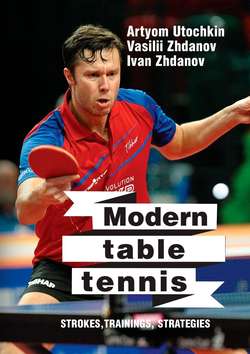Читать книгу Modern table tennis: strokes, trainings, strategies - Artyom Utochkin - Страница 13
Different variations of the forehand top-spin
Variation #4. Counter-loop from the middle zone
ОглавлениеCounter-loop from the middle zone is called “over-rotation” or “overspin” among the tennis players.
For example, if you hear an athlete says “won the point in overturn”, it means that there is a rally in a central zone when both opponents exchanged counter loops and he managed to win the point. In the future, we will designate this element as “overspin”.
So, the “overspin” occurs during matches not very often, because not all rallies end up with the setback to the middle zone of both athletes.
How does it happens that both athletes suddenly find themselves in the middle zone?
It all starts with the fact that one of the athletes begins to attacking, while the other seeks to not just play passively, but perform a counter-action. The most common counter-action in table tennis is counter-loop.
When one of the athletes starts to counterattack, he has to make a half step or a step back in order to have enough time for a counterattack. Counterattack – this element seizes ball’s speed and rotation and turns it back (making it a slightly powerful).
Therefore an athlete that has just performed a top-spin and received a counter-attack, has also to make a step back in order to have time to conduct his counterattack. And so with each following counter-loop athletes make a small step back as the ball is gaining a lot of airspeed and power. As a result, after one or two counter-loops athletes are already in the middle zone.
How the “overspin” differs from the top-spin against the block?
It differs with a slightly wider move,
because of the need to send the ball on a greater distance. The difference is in sending the ball to the opponent’s side from a distance of 1 meter or 2.5—4 meters, but the main difference is not the width of the movement, but also the time of handling the ball.
Ball handling should occur with a strong ball contact, meaning we should hold a ball on the racket for a longer time. As it’s expressed by the players – to sense it better. Longer contact with the ball is necessary to control the flight of the ball for a longer period of time and to be able to send the ball from a longer distance with the same accuracy as in the case of top-spin from the block.
“Overspins” in various zones are different by its performance. For example, there is a notable difference between “the overspin” from a distance of 2 meters from a table and the distance of 3.5 meters.
In the first case, the movement of a little shorter, ball handling occurs practically at the highest point of rebound and directed more forward. The power given to the ball by the opponent is clearly felt in the highest point. We fully return that power and speed back to the opponent.
In the second case, the ball begins to fall (that is, by this moment he had already passed the high point) and at this distance, the power of the ball given by the opponent is sensed much less. We have to add the ball more to spin and send the ball upwards to give it sufficient trajectory that will safely allow a ball to steer clear of a net and land on the opponent’s side.
